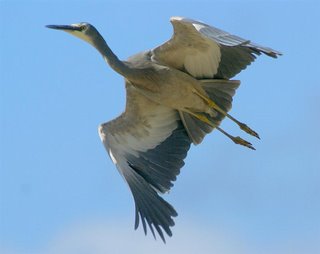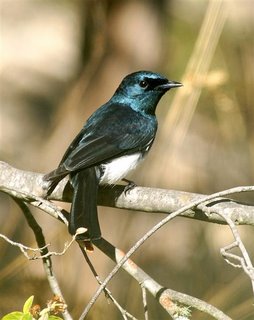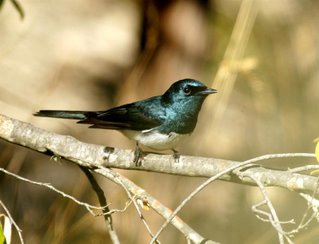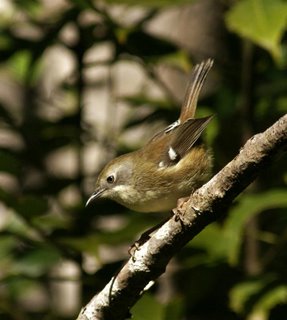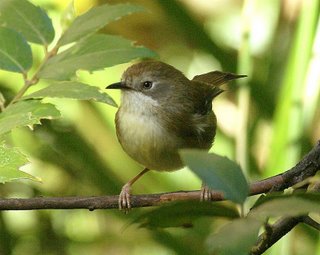 Ever since John Tongue mentioned, sometime ago, that he rarely saw Horsfield's Bronze Cuckoos, I've kept an eye out for them. During the Spring and Summer, I've come across, and several times photographed, Shining Bronze-Cuckoos, but rarely heard or seen the similar looking Horsfield's. In fact, I have seen Horsfield's in only 2 locations. Early in the Spring, there was a pair near the gate in the Meehan Range, and more recently, I've seen them in the Risdon Brook Park. So this morning, with rather overcast conditions, but very still, I spent an hour or so, trying to find the Horsfield's.
Ever since John Tongue mentioned, sometime ago, that he rarely saw Horsfield's Bronze Cuckoos, I've kept an eye out for them. During the Spring and Summer, I've come across, and several times photographed, Shining Bronze-Cuckoos, but rarely heard or seen the similar looking Horsfield's. In fact, I have seen Horsfield's in only 2 locations. Early in the Spring, there was a pair near the gate in the Meehan Range, and more recently, I've seen them in the Risdon Brook Park. So this morning, with rather overcast conditions, but very still, I spent an hour or so, trying to find the Horsfield's.I had seen Horsfield's in the same location at the Risdon Brook Park on a couple of occasions recently, so decided to concentrate my search there. It's an area on the eastern side of the park that was obviously once farmland. It consists of fairly open poor, rock strewn, pasture, with native grasses and old acacia trees, and a few young eucalypts now growing through. Perhaps, significantly, it's one of the areas where I have seen numerous flocks of Yellow-rumped and Brown, Thornbills. Both of these species build domed nests, which together with the Superb Fairy-wren, probably are the main species parasitised by this cuckoo in Tasmania. Apparently, some Fairy-wrens have developed an ability to recognise young Horsfield's and frequently abandon them (you can find more on that subject on the internet). I wandered around this area for some time, noting Pallid and Shining Bronze Cuckoos calling, before a short call that I couldn't identify, caught my attention. It had the 'quality' of a cuckoo, sounding somewhat like part of the Pallid's repertoire, but a different tone, certainly not a call I had previously associated with Horsfield's. Walking towards the source, I was passed by a small light brown bird travelling in shallow undulations, but fast--the first Horsfield's, a juvenile. The next hour was filled w
 ith some exasperation. I eventually found what I assume was the same bird, but this time it was with an adult (image at left). I was quite surprised to find an adult with a juvenile, given that the adult hadn't reared the youngster, but perhaps this regularly happens once the juvenile is fully grown and leaves the host parents. I tried hard to get meaningful photos, but the poor light conditions, and the timidity of the birds, made this difficult and the shots shown here were taken from 50 or more metres away. My overall impression of the Horsfield's Bronze-Cuckoo in the South East at least, is that it has significantly declined since the 70's. I note that my sightings have both been at sites where Yellow-rumped Thornbills are common, another species that has also declined in that time frame, largely I suspect from habitat loss and possibly changing farming practices. Whether there is any real connection is supposition on my part, but it might explain the cuckoo's decline.
ith some exasperation. I eventually found what I assume was the same bird, but this time it was with an adult (image at left). I was quite surprised to find an adult with a juvenile, given that the adult hadn't reared the youngster, but perhaps this regularly happens once the juvenile is fully grown and leaves the host parents. I tried hard to get meaningful photos, but the poor light conditions, and the timidity of the birds, made this difficult and the shots shown here were taken from 50 or more metres away. My overall impression of the Horsfield's Bronze-Cuckoo in the South East at least, is that it has significantly declined since the 70's. I note that my sightings have both been at sites where Yellow-rumped Thornbills are common, another species that has also declined in that time frame, largely I suspect from habitat loss and possibly changing farming practices. Whether there is any real connection is supposition on my part, but it might explain the cuckoo's decline.Happy New Year to You All































